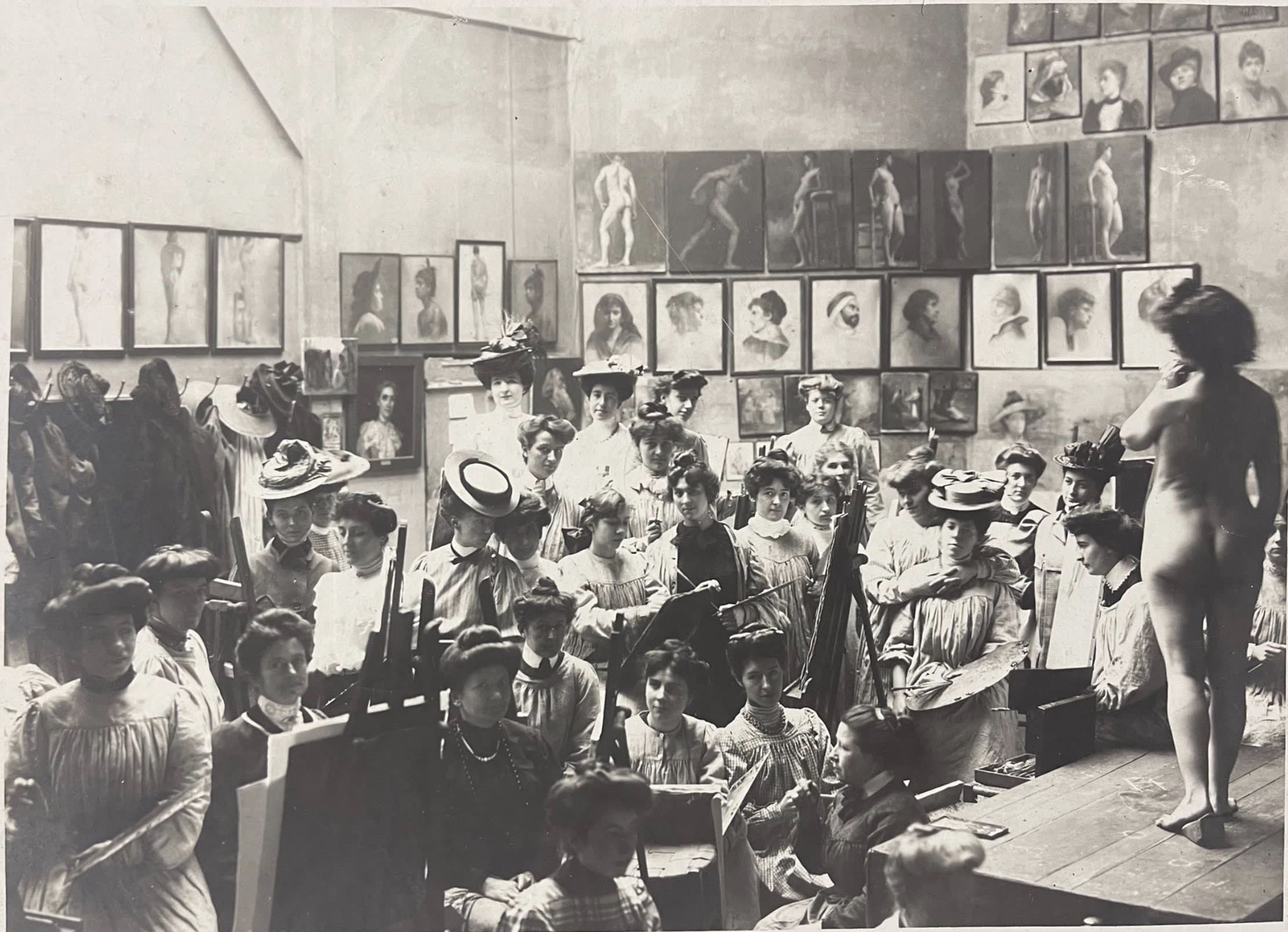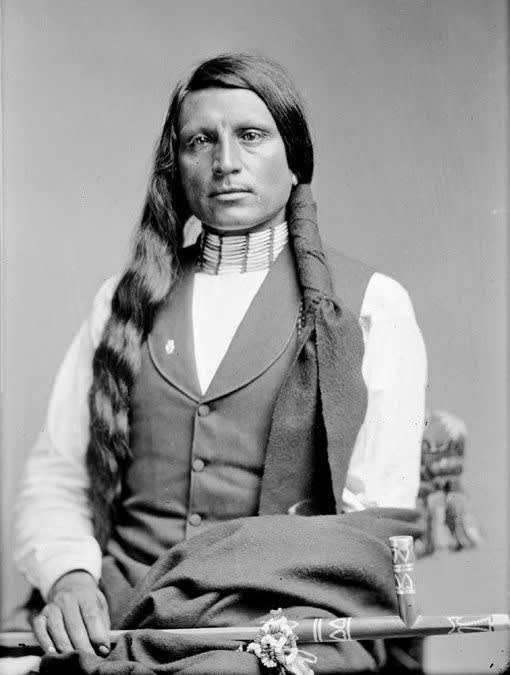Lucie Attinger (1859 - 1928)
Profile study of a model dressed as a Native American
Signed upper right: L. ATTINGER
Gouache on card
42.6 x 33.4 cm. (16 ¾ x 13 ¼ in.)
Profile study of a model dressed as a Native American
Signed upper right: L. ATTINGER
Gouache on card
42.6 x 33.4 cm. (16 ¾ x 13 ¼ in.)
Lucie Attinger’s study of a model dressed in Native American attire is an exciting reappearance on the market, aiding both our understanding of the Swiss artist’s career and output and, fascinatingly, giving an insight into the studio practice at the Académie Julien, a pioneering art school where, for the first time, a woman could be taught with the same opportunities as men. A rare work by Attinger, of fine quality and in excellent condition, this gouache is a captivating rediscovery within the nascent field dedicated to the study of female artists at the Académie Julien.
Lucie Attinger
Lucie Charlotte Attinger was born on 1 March 1859 in Neuchâtel, in western Switzerland, to James Attinger, a well-known local book publisher, and Sophie Röthlisberger. Attinger was one of eight children. She studied initially in Neuchâtel with Georges Grisel and Auguste Bachelin (fig. 1), a versatile artist whose oeuvre consists mainly of genre scenes and landscapes, and her work was first exhibited in her hometown in 1880. Attinger subsequently moved to Paris to attend the Académie Julian, the pre-eminent art school for women on a global level. The lessons there were almost entirely technical, centred around life classes, and indeed it was its reputation for excellence in academic figure studies, alongside the calibre of teachers, such as leading Salon jury members like Jules Lefebvre, Joseph-Benjamin Constant, Jean-Paul Laurens and William Adolphe Bouguereau, that drew international students to the Académie. In 1893 Attinger married Henri Busquet de Caument (1859-1937), from an old aristocratic family, and they had two daughters. She died in Neuilly-sur-Seine on 10 June 1929.[1]
Fig. 1, Auguste Bachelin, Kitchen Interior, oil on canvas,
dimensions unknown, location unknown
Fig. 2, Lucie Attinger, Jean l’Etourdi, 1886, Épinal print, Musée
de l’Image, Ville d’Épinal
As an artist, Attinger, despite her talents, does not seem to have been very prolific, exhibiting only once at the Salon in 1889. Her works are therefore rare on the market, with this being one of only a small handful of artworks to have appeared publicly over the last three decades. The evidence suggests that she was comfortable across diverse subject matter and media, painting still life, genre scenes and landscapes, amongst other themes, in both oils and watercolours. She was also active as an illustrator throughout her career, commissioned to provide work for several Parisian magazines and children’s books. In terms of the latter, she worked primarily with the Maison Quantin publishing house, illustrating their stories in the tradition of Épinal prints (fig. 2).
Attinger’s Model
Remarkably, we can link Attinger’s gouache to other works executed in the studios of the Académie Julian, given the existence of a photograph of one of the Académie’s ateliers in which two artworks of the same model are clearly visible hanging on the wall at the back (fig. 3). Furthermore, a pastel by Marie-Thérèse Duchâteau (fig. 4), a fellow student at the Académie, has recently appeared on the Belgian art market of the same sitter, inscribed on the reverse 1892, and thereby giving a date to Attinger’s work.

Fig. 3, Photograph from circa 1892 depicting a life model class at the Académie Julian
In all these works, the model is dressed as a Native American, as made apparent by her upswept black hair, held in place by two feathers, whose quills cross over each other. In Attinger and Duchâteau’s studies, the sitter wears a gold hooped earring, which probably also appears in the works in the photograph but cannot be seen from that distance. Whilst the other three works depict the model at bust-length and at three-quarters profile, Attinger draws the sitter in profile, and includes the torso, allowing for the inclusion of a quiver of arrows, a bow and a gold arm band.
Fig. 4, Marie-Thérèse Duchâteau, Head study of a Native Indian,
pastel on paper, 27.4 x 35.6 cm, Gillis Goldman Fine Art
Attinger’s image is also the only one in which the sitter’s head is at eye level. In the other three examples, the model is seen slightly from below, in keeping with studio practice at the Académie, where the model was usually seated or stood on a pedestal, with the artist’s therefore looking upwards as they rendered the likeness. Furthermore, the students would be instructed by the teacher how much of the model they were to include in the finished work, so Attinger would not have been able to diverge from a head study in the class. Bearing this in mind, it seems likely that Attinger’s gouache was executed after a life class, with the artist perhaps using her own bust-length head study as the basis. For whatever reason, Attinger was keen to enlarge the composition and add other elements reinforcing the model’s Native American identity.
Unanswerable as it stands, but tantalising to consider, is the question of whether the model was indeed a Native American, rather than a European of olive complexion dressed as one. Indeed, around this time there was a noted interest in Native American culture in Paris, thanks to Buffalo Bill’s visit to the city in 1889 for the Exposition Universelle. His spectacle, Buffalo Bill’s Wild West, was presented to great acclaim, drawing unprecedented crowds and garnering pages of press columns. Amongst the 245 performers in the show were many Native Americans, including the famous Oglala Lakota chief Red Shirt (fig. 5), who soon became an international celebrity. It is therefore not impossible that three years later, a young Native American woman would be in Paris and was hired as a studio model at the Académie Julian. Hopefully further studies of the sitter from the Académie may emerge in the future, shedding more light on this question, and providing further context for Attinger’s gouache.

Fig. 5, Chief Redshirt, circa 1880
[1] The biographical information derives from Benezit (op cit) and R. de Caumont, Busquet de Caumont: Histoire Culturelle, sociologique et patrimonique d’une ancienne famille normande, Paris 2012, p. 180.
